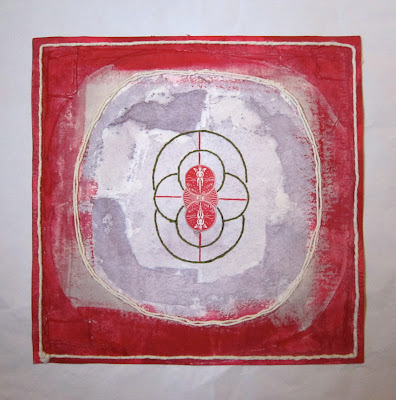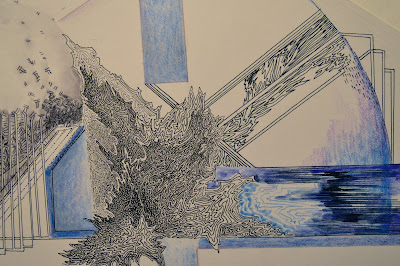Hello again, I have something very awesome that I have been saving for a short time. Within the last few months, I asked Alexis Iammarino and her father, Richard Iammarino some questions. Here they are in all their interesting glory...
Knowing that you and your father are both practicing artists, had you ever worked with him on a visual art piece before? (If so, can you describe or link it for us?)
We used to play a game of I draw you draw when I was a kid. Dad says, "Sometimes we'd just start with a mark on the paper and take from there. See what it would become." I have a few journal pages from when I'm 5 years old or so and you can see that we often drew together. But we have not worked together in this way, through the mail and with the intent of making a collaborative art piece as adults. We spend a lot of our weekly phone calls discussing and checking up on what each other are up to. We talk about art a lot. But as far as executing a piece together, this is our first time.
*Side note: We have worked together on decorative painting projects in private residences. We once did a HUGE floor painting, it was faux marquetry to restore this massive Russian medallion (Geometrically a massive mandala in a way! HA!). That was a beast of a project and what I remember most about that process was how seamless our problem solving was. We figured it out with more or less total confidence in each other we pulled it off. It was such a feat in it's scale.
What is the difference between working with your father, side-by-side and working by yourself in the studio on these mandala pieces (I know that you worked in both ways)?
Certainly it's a big surprise when it comes through the mail...Dad never knew what to expect. And he knows me well, so I guess he could expect that he would be surprised. I'd handle the progression in bolder less incremental ways. I'm more spontaneous and he's a bit of thinker about it. We're sitting here thinking this over and we're saying that he'd unpack them and think for days about what to do next, whereas I'd open and take a look and respond pretty immediately.
The difference between working on it side-by-side, which was just a week when he's been visiting, from working on it in our own space for months. The difference is, we can field each others opinions and collaborate when we're together in the same room. Dad just said that maybe we're responding and doing what we want when it arrives in the mail, sorta like the balls in your court, you respond and do what you want. Then I asked, do you think we're not collaborating when we're apart? He answers, "Of course we're collaborating, but it's not the same - we're trying to pull the different approaches. We certainly have different approaches. We come from entirely different background in terms of our age, simply and also information/training and influences. But the same time we understand what we're doing, our thought process is very similar."
Process wise for me, it was different in that I was working more slowly on our piece when Dad and I were working together in the same space. We've just exchanged thoughts about how he can be more critical about the minute decisions (self critical in terms of what would effect what, BUT this really has not so much to with this piece it self, but instead it has to do with how he's been tackling his current paintings in E. Cambridge) and I was just playful and felt that whatever we did could be figured out, or resolvable. He's just reminded me that this was all a very playful process between us and that it wasn't as natural to work such boldly with colors. He thinks that was a challenge in unifying the composition and the wholeness of it because our color sensibilities differ so much.
He became very invested in 'tying it all together' to create a 'unified design'. And towards the end the last few days he made a bold suggestion to pick up some colored vellum/acetate to introduce color to the black and white areas. He thought of it as a glaze from his own painting practices....neat-O huh?
You tend to work very collaboratively being a community artist and arts/dance facilitator, but do you have any new insights into the collaborative process, in working with him?
Shana, this could be a shocker - wait for it, wait for it......
We're sitting here and we're asking ourselves did we do a mandala? Oh my. We've been sharing drawings in the mail and responding to one another. We've both introduced circles, spherical motifs, but in the sense that we've not been working from a center and building out concentrically. Shana, this actually feeling sorta wild, he just said to me "Oooo, making a mandala would have been fun!". I mentioned that other folks were making mandalas with the ATCTE, but now as we sit here, I have this feeling if only initially like I've misguided us in a way, at least in that we didn't make this piece as a Mandala.
Actually feel a little flabbergasted - anyway we're gonna finish what we've been working on and see if it seems to resonate with the work you've been collecting. I'll have to write back to you. Tell me, is it possible that we did this wrong? I don't think we've being playing my the rules here...seems silly, like a curve ball to throw your way. Wow.
Meanwhile, dad wants to do a Mandala with me.
I always think of you foremost as a dancer because of your physical energy. and constant movement. If you were tasked to 'illustrate' the concept of the mandala with the human body as your medium, what do you think it would look like? Is it possible to describe it or sketch it?
The strongest example from my personal experience that would best illustrate a the concept of a mandala is
this excerpt of a piece I collaborated on with my dearest and nearest dance collaborator Lindsay Levesque. I am in the pink and she wears the white shirt.
Why I share this is that what you see here is a choreographic structure based on our own respective movement phrases, done with no counts and phrased only using the similarities of our body's frames - literally the length of our legs and so on. We are proportionately similar and we allowed our timing to be determinant of the speed and ease that we both have moving in and out of the floor or from low to high - The material you see here is material we've rehearsed and rehearsed countless times for each other witnessing the differences and making minute changes to make the material meld into a seamless set of movements that have been sequenced in such a way that we always realign in perfect unison even when we can't see each other.
This is like the collaborative mandala in that sense that the participants/performers seek a certain unity even as they pursue separate formal trajectories in the same space and time. Also our choice of how to integrate the sound for this piece was mandala-like.
We both selected pieces of music and they were played simultaneously as a single track in stereo, from their own speakers to create a unique piece unintended by the composers. One was an instrumental composed by Arvo Part and the chant was early European/Georgian a cappella chants. The length, the finality of the piece was determined by playing both songs on repeat until they ended on the same note...that was over 15 mins.
There are two more dancers in this section. Although there were four performers we really conceived of each pair as a solo because of the level of specificity and how the unison was achieved by deep team work and physical listening. For instance in the sections of the piece when all four of us were out there we were a duet.
This piece was the final section in an evening length work that she and I set for our senior project at Goucher College. It was the first and most profound and most instructive of any collaboration I've participated in to date. Really.
Wow right? This of course comes to mind.
I am not familiar with this company or their cause, I came across it watching other whirling dervish footage on youtube. What I observe here also relates to the idea of mandala: there is centered focal point/individual that generates energy or engine for peripheral agents that feed back and compliment it with minute, coordinated gestures and subtle shifts of weight.
Turning the Tables: Now it's your turn to ask me a question! Anything you like, and you'll find my answer on the blog, along with your interview...Alexis asks...
What is the most pervasive self-reflexive observation participants make about their role as a collaborator in this project?
Hmm, like meta-art? You know, I don't think I would have been able to answer this question until I curated the actual show and saw them all together in one cohesive group....and it really was surprisingly cohesive. But I think I've found that the references within the pieces are all very elemental. True, everyone brought their own meaning to the mandala, and it seems to tie in with where their interest are as artists and human beings.
Heather is part Native American, so she referenced birds and wings in both of her pieces with me. There were quite a few other natural elements involved with animals and or myth: a turtle, snake, eagle, spider, scarab beetle, raven, nymph. Danielle and Brian both do math based art, so a bit of "sacred geometry" was reflected...there were also a few pieces that involved the idea of space/the universe/galaxies. One that stunned me when I opened it was Wes and his two year old daughter's piece. What they created bore a striking resemblance to the "tree of life", it actually took my breath away upon first glance...she created something so elemental. Stunning.
We had some flower motifs, quite a few sticks and branches, which were collected by me and Elbee, and Paula mentioned drawing with a pecan branch into the earth when she was young. Her statement actually encapsulated a lot for me, and when I read it aloud at the artist talk I had a hard time of it...just because it meant everything and it was so powerful for me to read to others. I thought, "This is what the project is all about." It was so simple and gorgeous, it got to the heart of creating...so I think it speaks to some universal principles about the mandala and my hopes for the project.
“I can remember making art at three years old. My first paintbrush was a twig from my grandfather’s pecan tree; my first canvas was the earth itself. I remember being five year old, swinging by my knees from a low-hung, makeshift trapeze, etching into the soil spirals and circles that had meaning only for me. The act of drawing was beautiful to me and gave me peace of mind. It still does..."
-Paula Phillips
So yeah, the short answer is: people used what they knew and were familiar with, they leaned on and borrowed from their natural environment, myth, science, math, dreams and the universe. PERFECTLY self reflexive, if you ask me.




















































